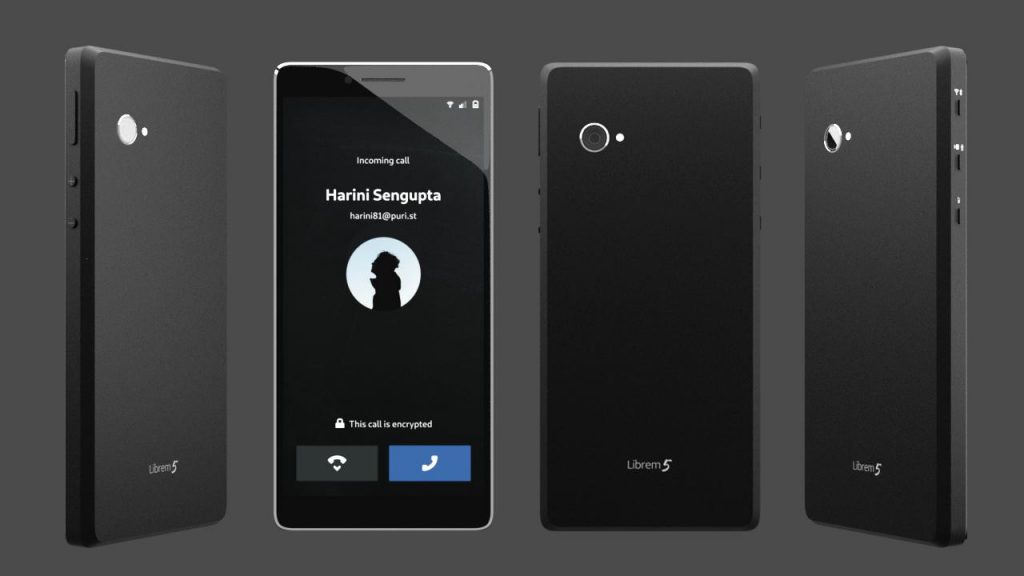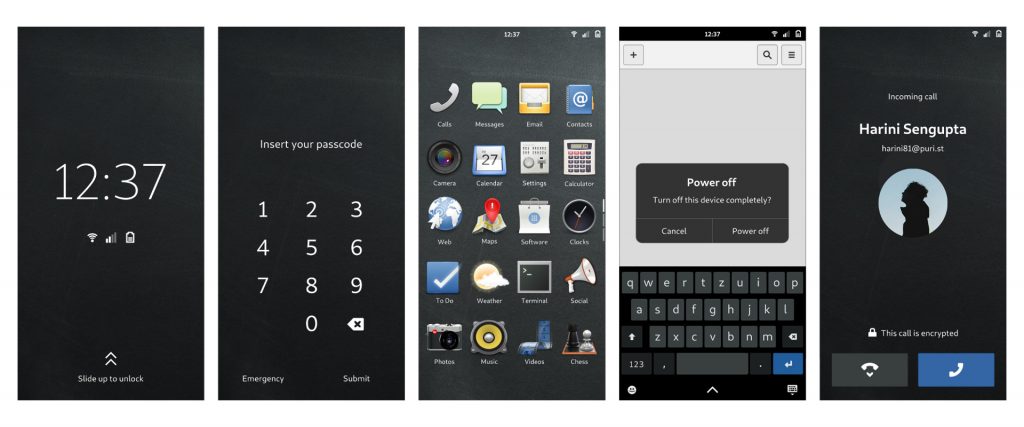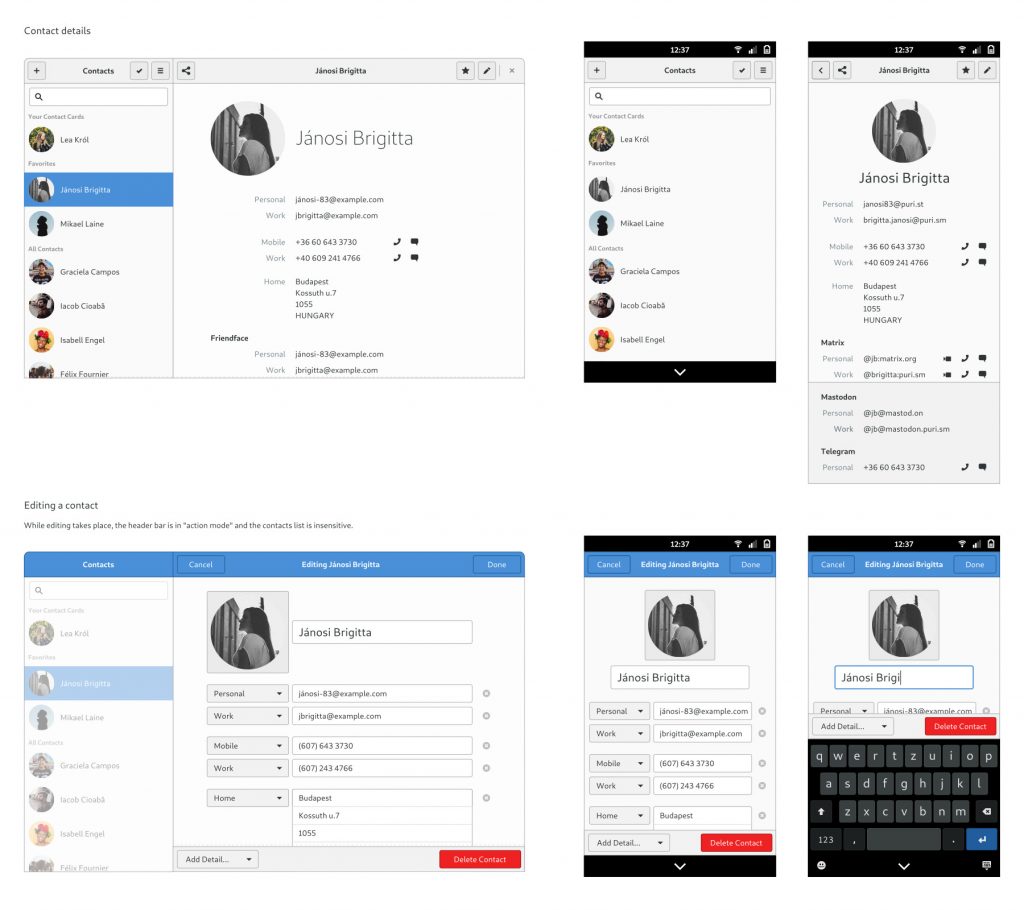Librem 5 design report #5
François Téchené
Latest posts by François Téchené (see all)
- Black Friday - November 29, 2024
- Replacing the Screen of Your Librem 5 - January 25, 2024
- Working with the Librem 14 - November 22, 2023
Hello everyone! A lot has happened behind the scenes since my last design report. Until now, I have been reporting on our design work mainly on the software front, but our effort is obviously not limited to that. The experience that people can have with their physical device is also very important. So in this post I will summarize some recent design decisions we have made both on the software side and the hardware product “experience” design.
Thinking about the physical shell
Our goal with the Librem 5 is to improve the visual identity of the Librem line while staying close to the minimalist and humble look that characterize the existing Librem line.
The main challenge of case design is the need to balance aesthetics, ergonomics, convenience, and technical limitations.
As you know, the Librem 5 is a special phone that will not integrate the same CPU and chipsets as usually implemented in the vast majority of smartphones in the market. Power consumption is a very important factor to take into account, but so is battery capacity and printed circuit board arrangements, and we don’t want to sacrifice battery life for a few millimeters of thickness. Therefore:
- We are now aiming for a 5.5″ to 5.7″ screen with a 18:9 ratio that would let us incorporate a larger battery without affecting the shape of the phone.
- We are also opting for a shape with chamfered edges (as pictured below), instead of the usual rounded ones. Not only do we think it looks elegant, the general shape would provide a better grip and it give us a bit more room inside for components.
Simplifying the UI shell
As the implementation of the Librem 5 goes on, we are quite aware that time is limited given our January 2019 target, and we are therefore focusing on robustness and efficiency for the first version of the mobile UI shell (“phosh”), which we wish to push upstream to become the GNOME mobile shell. As you may recall from our technical report from early March, we had discussed with GNOME Shell maintainers, who recommended this clean-slate approach.
We revisited the shell features and decided to split the design and implementation into several phases.
Phase 1 defines a shell that is at its simplest state in term of features and usability. This is the shell that should ship with the Librem 5 in January 2019.
This shell includes :
- A lock screen.
- A PIN-based unlock screen for protecting the session.
- A home screen that displays a paginated list of installed applications.
- A top bar that displays useful information such as the time, battery level, audio level, network status…
- A bottom bar that simulates a home button (only visible when opening an application).
- A virtual keyboard.
- Incoming call notifications.
The “call” app is indeed a special case application on a phone, and that’s why we’re prioritizing it for the notifications feature: it has to work from day one, and it has some requirements like the ability to interact directly on the lock screen (to answer an incoming call, or to place an emergency services call).
Multitasking UI workflows, search and more flexible app notification features/APIs should be implemented during phase 2, available a bit later.
While “phase 1” might not be the all-you-can-eat features buffet some may be accustomed to, we think that this minimalist shell will be extremely simple to learn, use and will favor a quick and painless adoption. And it’ll be a great starting point.
Designing the Contacts application
The Contacts application will be at the center of the communication features. It is the application that will handle the contacts management that other applications such as Calls or Messages will rely on.
For that matter, we are adapting the existing Contacts application by designing its mobile layout and adding extra fields that will be required by the different communication applications.
Librem 5 & Fractal team hackfest in Strasbourg
This week, a few members of the Librem 5 team (including myself) are attending the 2018 Fractal design hackfest in Strasbourg, with the goal of helping the Fractal team to make a beautiful and secure Matrix-based IM application to be used on both the desktop and mobile platform. I hope to do a report on the communication features of the Librem 5 in a future post where I will talk about what happened at the Fractal hackfest.
Recent Posts
- Google to Pay Texas $1.4 Billion to End Privacy Cases
- Trump T1 Phone Android OS vs. PureOS
- After a week, Trump Mobile drops claim that the T1 Phone is “Made in the USA”
- The 2025 Most Secure Phone in The World Reviews Are In: Efani, Analytics Insight, Navi, and Cashify
- Why Purism Manufactures Electronics in the USA
Related Content
- Hidden Operating Systems in Chips vs. Secure, Auditable OSes: A Cybersecurity Comparison
- Apple Moves iPhone Production to India—Purism Has Been Leading the Way for Years
- What Is PureOS? A Beginner’s Guide for iOS, Android, and Windows Users
- Freedom of Choice vs. Oppression of Big Tech
- From the Hackdesk: Librem 16





